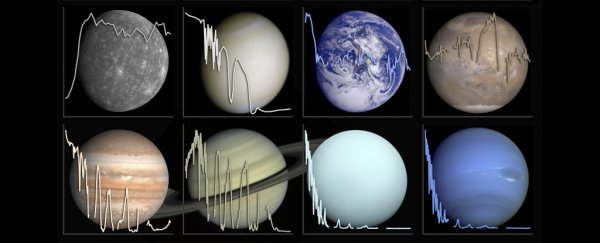How do you identify an exoplanet? Often the way it behaves gravitationally is a big clue, but studying the way it reflects light - its spectrum - can also be invaluable.
To that end, astronomers have created a catalogue of 'light fingerprints': spectral profiles for 19 Solar System bodies, so we can have a better idea of what the spectra of distant exoplanets actually signify.
The new catalogue consists of the calibrated spectra and geometric albedos - a measure of the brightness - of the eight planets in the Solar System, nine moons, and two dwarf planets.
It also includes information about how the colours of these bodies would change if they were orbiting other stars.
"We use our own Solar System and all we know about its incredible diversity of fascinating worlds as our Rosetta Stone," said astronomer Lisa Kaltenegger of the Carl Sagan Institute, which has released the catalogue for free.
"With this catalogue of light-fingerprints, we will be able to compare new observations of exoplanets to objects in our own Solar System - including the gaseous worlds of Jupiter and Saturn, the icy worlds of Europa, the volcanic world of Io and our own life-filled planet."
It's not often that we're able to observe an exoplanet directly. Many are in fact found using something called the 'transit method': when a planet orbits in front of its star, we are able to ascertain its presence by the way the star dims. This is how Kepler, and now TESS, hunt for exoplanets.
This can actually tell us a lot more about the planet than the fact that it's there. For example, a larger planet will cause a greater dimming effect than a smaller one, so we can infer its size.
When combined with the radial velocity method - which measures a star's wobble due to planetary gravity - astronomers can also figure out a planet's mass. This combined size and mass information is usually used to infer a planet's properties, since rocky planets seem to have an upper size limit.
As for the planet's spectrum, that takes some real ingenuity, and it was only figured out around a decade ago. You obtain spectroscopic information from the star when the planet is in front of it, and again when the planet is behind it, and therefore not in the picture.
Then you can subtract the star's spectrum from the data with the planet in front. What remains is the planet's spectrum.
So far, this is still pretty limited. But when the incredibly powerful James Webb Space Telescope launches in a few years, it will be strong enough to image these far-away planets directly like never before.
"Planetary science broke new ground in the '70s and '80s with spectral measurements for Solar System bodies. Exoplanet science will see a similar renaissance in the near future," said planetary scientist Jack Madden of the Carl Sagan Institute and lead author of the study.
"With the upcoming launch of the James Webb Space Telescope and the current construction of large ground-based telescopes such as the Giant Magellan Telescope and the Extremely Large Telescope, we are entering a new age of observational ability, so we need a reference catalogue of all the planets and moons we already know, to compare these new exoplanet spectra to."
The new catalogue will help astronomers plan for observation time with these instruments, which will be in very high demand.
Comparing spectra will allow them to narrow down what they're looking at - whether it's a rocky body or a gaseous one, for instance, within certain limits. A planet like Venus is a good example - although it's rocky, its incredibly dense, highly reflective atmosphere gives it the characteristics of both a gaseous planet and an icy body.
But that, too, is valuable information that can help characterise exoplanets, since Venus is neither as large as a gas planet, nor as small as an ice moon.
"By unravelling the mysteries of the objects in our own Solar System," Kaltenegger said, "we can glimpse the secrets of these new worlds we are finding."
The team's paper describing their methods has been published in the journal Astrobiology, and the catalogue can be found on the Carl Sagan Institute website.
